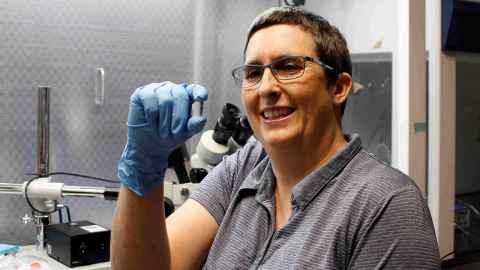Inside out and outside in - the quest to measure intracranial pressure
4 July 2023
Two projects exploring out-of-the-box methods to measure brain pressure are driving ahead with funding from the latest HRC funding round.

Dr Sarah-Jane Guild, Senior Research Fellow in Physiology at Waipapa Taumata Rau, University of Auckland and part of the Implantable Devices Group at the Auckland Bioengineering Institute (ABI), has been awarded $1.2M to pursue the safety and reliability of a long-term implantable electronic medical device.
“We are developing a small wireless pressure sensor for use in patients with hydrocephalus (fluid around the brain). Our aim is to place the long-term pressure sensor into the brains of patients with hydrocephalus to allow them to monitor the increased pressure caused by a build-up of fluid around the brain.”
Hydrocephalus is the most common neurosurgical condition in children. It is currently treated with the surgical insertion of a shunt, a flexible tube that is inserted into the brain to drain the excess fluid into another part of the body. However, shunts have a high failure rate, particularly in children. When a shunt fails, symptoms such as headache, nausea, vomiting or behaviour changes signal that fluid is accumulating, and pressure is building up again. This means a lot of anxiety for patients, parents and caregivers as they never know if symptoms are signs of a serious shunt failure or just an everyday illness. Around 70 percent of the time it is not the shunt failing but currently this requires hospital evaluation to determine.
The new wireless pressure sensor system will provide a tool for parents, caregivers, and patients themselves to monitor the pressure in the brain remotely via a sensor placed alongside the drainage tube. The device would offer patients and caregivers both peace of mind and early warning of a likely blockage, thus preventing unnecessary hospitalisations.
The next stage of research, prior to advancing to human clinical trials, is to test the device in sheep. Sheep are used, due to the brain being a comparable size in humans and with similar characteristics such as the flow and absorption rate of fluid.
Dr Guild says, “The ultimate goal is to provide the evidence that our device is safe and suitable for clinical use and to obtain regulatory approval, so that patients living with hydrocephalus and their whānau can have the quality of life they deserve knowing that they will be able to tell when their shunt is failing.”
The goal is to provide the evidence that the device is safe and suitable
for clinical use so that patients living with hydrocephalus can have the quality of life they deserve
Dr Sarah-Jane Guild and several other bioengineers and scientists from ABI and the Faculty of Medical and Health Sciences are also collaborating with Dr Samantha Holdsworth, Chief Executive and Research Director from Mātai Medical Research Institute on another HRC-funded project looking at brain pressure.
Currently, the only way to accurately diagnose an increase in intracranial pressure is to measure it through a hole drilled into the patient’s skull. The Mātai project is developing and testing a new non-invasive technique using amplified MRI (aMRI) to diagnose an increase in intracranial pressure.
aMRI amplifies subtle spatial variations in MRI scans and enhances the microscopic motion that occurs in the brain as the heart pumps blood around it. This provides a more intricate view of the brain. Data from the aMRI scans of patients with elevated brain pressure is crunched to create advanced models.
Dr Gonzalo Maso Talou, senior research fellow and leader of the Animus Laboratory at ABI, is the co-principal investigator of the Mātai project and is leading the MRI-informed computational modelling work. It is hoped this work will provide a diagnostic index of intracranial pressure.
Dr Guild says, “The idea of the project with Mātai is to develop a diagnostic technique using clinic-based MRI as a quick and non-invasive measure of intracranial pressure. This would help better manage conditions such as head injuries, brain tumours and meningitis. In comparison, the long-term wireless intracranial pressure system from the ABI project would allow patients to make measurements in their own home. This would be a game-changer for people with chronic conditions, especially those who live outside the main centres and further from advanced hospital care.
“It is an ambitious approach with the potential to revolutionise patient management.”
Media enquiries:
Megan Fowlie
M: 022 301 0334
E: megan.fowlie@auckland.ac.nz